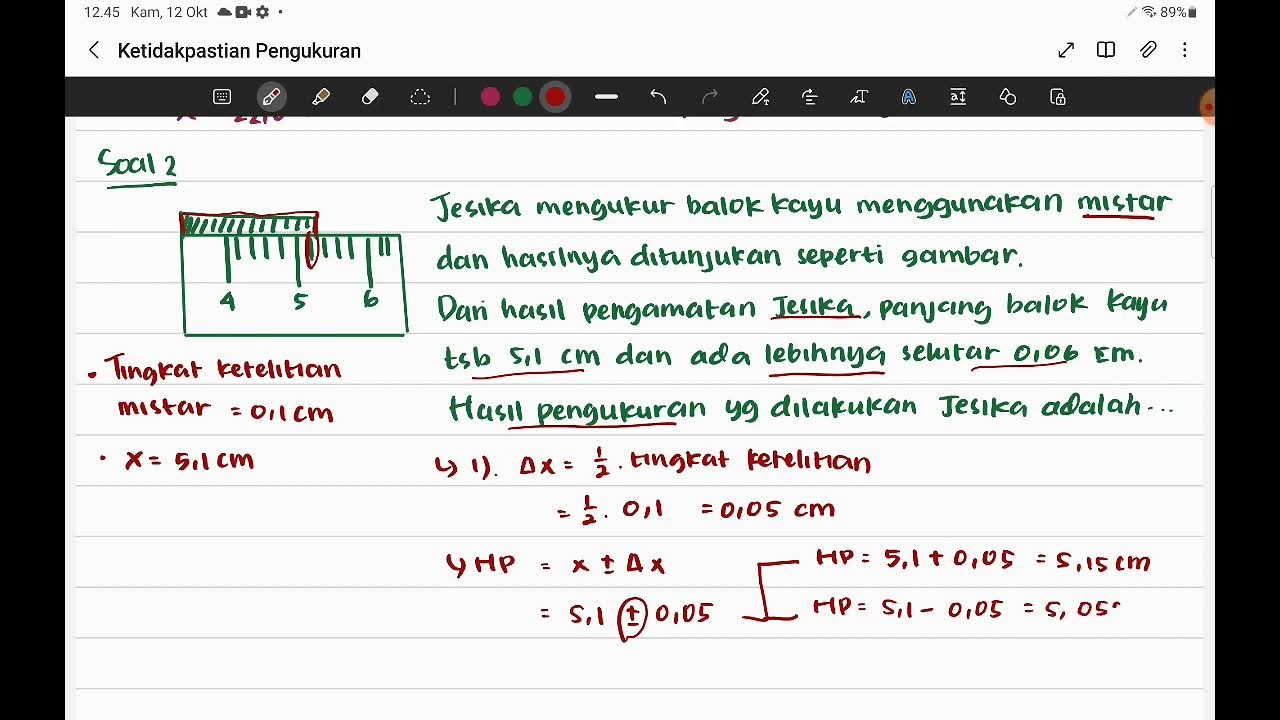Praktikum Fisika Dasar I || Modul 1 Pengukuran dan Ketidakpastian
Summary
TLDRJessica Putri, an Informatics Engineering student, guides through Basic Physics Practicum 1 Module 1, focusing on measurement and uncertainty. She explains the importance of repeated measurements to reduce uncertainty and reliability in physical measurements. The practicum involves using tools like rulers, calipers, micrometers, and balances to measure dimensions and mass of materials. Jessica demonstrates how to calculate length, width, height, volume, and density, emphasizing the significance of entering data into tables for analysis. She also covers the calculation of average values, standard deviations, and accuracy, providing a comprehensive approach to understanding measurement techniques in physics.
Takeaways
- 📏 **Measurement Fundamentals**: The practicum introduces the basics of physical measurements, emphasizing the importance of accurate tools and methods.
- 🔍 **Types of Measurements**: It distinguishes between single measurements and repeated measurements, with the latter aiming to reduce uncertainty.
- 📐 **Uncertainty Sources**: The script explains that uncertainty in measurements can arise from the smallest scale value, random errors, and observer limitations.
- 🛠️ **Practicum Tools**: Various instruments are used in the practicum, including rulers, calipers, micrometers, and balances, each for specific measurement types.
- 🧩 **Experiment Materials**: The practicum involves measuring the dimensions and mass of aluminum blocks, copper blocks, and iron balls.
- 🔢 **Data Collection**: Emphasizes the need for collecting data through repeated trials to ensure reliability and accuracy in measurements.
- 📊 **Data Processing**: Introduces statistical methods like calculating the average (x bar), standard deviation (Delta X), and accuracy of measurements.
- 📚 **Practicum Modules**: The script outlines a structured approach to the practicum, with Module 1 focusing on measurement and uncertainty.
- 👩🔬 **Practicum Facilitation**: Jessica Putri, an Informatics Engineering student, guides the practicum, providing a hands-on learning experience.
- 📋 **Documentation**: Stresses the importance of recording and tabulating data meticulously for analysis and future reference.
Q & A
What is the main topic of the basic physics practicum 1 Module 1?
-The main topic of the basic physics practicum 1 Module 1 is about measurement and uncertainty.
Who is guiding the basic physics practicum 1 Module 1?
-Jessica Putri from the Informatics Engineering study program batch 2020 with NIM 1201400500 is guiding the practicum.
What are the two types of measurements mentioned in the script?
-The two types of measurements mentioned are single measurements (x = x̄ ± Δx) and repeated measurements.
Why is the smallest scale value important in measurements?
-The smallest scale value is important because it helps to determine the precision of the measurement and contributes to the calculation of uncertainty.
What causes the first type of uncertainty in measurements?
-The first type of uncertainty is caused by the smallest scale value of uncertainty with a random uncertainty system and also the limitations of the observers.
What are the basic measuring instruments used in the practicum?
-The basic measuring instruments used in the practicum include a ruler, caliper, screw micrometer, Ohaus balance, and a digital balance.
What materials are used for the experiments in the practicum?
-The materials used for the experiments are an aluminum block, a copper block, and an iron ball.
How many experiments are conducted in the practicum?
-Five experiments are conducted in the practicum.
What is the purpose of using repeated measurements in the practicum?
-The purpose of using repeated measurements is to make the true value of a measurement more reliable and to reduce uncertainty.
How is the average value (x̄) calculated in the experiments?
-The average value (x̄) is calculated by summing the results of all experiments (X1 + X2 + X3) and dividing by the number of trials (n), where n is the number of experiments conducted.
What is the formula used to calculate the standard deviation (Δx) in the practicum?
-The formula used to calculate the standard deviation (Δx) is the square root of the sum of (X̄ - Xi)^2 divided by (n - 1), where X̄ is the average, Xi is each individual measurement, and n is the number of measurements.
How is the accuracy of the measurements determined in the practicum?
-The accuracy of the measurements is determined by the formula 1 - (Δx / X̄) * 100%, where Δx is the standard deviation and X̄ is the average value.
Outlines

هذا القسم متوفر فقط للمشتركين. يرجى الترقية للوصول إلى هذه الميزة.
قم بالترقية الآنMindmap

هذا القسم متوفر فقط للمشتركين. يرجى الترقية للوصول إلى هذه الميزة.
قم بالترقية الآنKeywords

هذا القسم متوفر فقط للمشتركين. يرجى الترقية للوصول إلى هذه الميزة.
قم بالترقية الآنHighlights

هذا القسم متوفر فقط للمشتركين. يرجى الترقية للوصول إلى هذه الميزة.
قم بالترقية الآنTranscripts

هذا القسم متوفر فقط للمشتركين. يرجى الترقية للوصول إلى هذه الميزة.
قم بالترقية الآنتصفح المزيد من مقاطع الفيديو ذات الصلة

[Praktikum Oarkom 1] Modul 1: Marie Simulator & Marie Assembly Language

Hakikat Fisika, Besaran dan Pengukurannya SMA Kelas X Kurikulum Merdeka | Physics Time

Ketidakpastian Pengukuran Tunggal Fisika 10 SMA KMerdeka

Basic Electrical Engineering | Module 3 | Syllabus Overview of Three Phase AC Circuits (Lecture 19)

TEKNIK INFORMATIKA

FISIKA KELAS X | KETIDAKPASTIAN PENGUKURAN TUNGGAL. PART 2
5.0 / 5 (0 votes)
